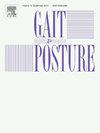Comparing the effects of Kinesio and dynamic tapes on plantar pressure and postural stability in the pre- and post-fatigue phases: The case of men with pes planus
IF 2.2
3区 医学
Q3 NEUROSCIENCES
引用次数: 0
Abstract
Background
Pes planus (PP) is a common foot arch disorder. The present research was conducted to compare the effectiveness of Kinesio tape (KT) and dynamic tape (DT) in treating postural fluctuations during the pre-and post-fatigue phases in males with PP.
Methods
In this crossover study, 35 men with PP were recruited. The participants attended intervention sessions on three different days. At the onset of each session, one condition—either a session without taping (WT), KT use, or DT application—was randomly selected. Afterward, plantar pressure and postural fluctuations were recorded before and after fatigue under the chosen condition with pedoscan. The taping technique used was the modified low-dye tape (LDT) method.
Results
The study found that before fatigue, plantar pressure distribution increased significantly in the lateral areas and decreased in the medial areas with DT and KT compared to WT (p = 0.03). After fatigue, DT resulted in more lateral pressure and lower medial pressure than WT (both p = 0.035). Regarding the center of pressure (CoP), maximum posterior fluctuations decreased significantly after fatigue with DT compared to KT (p = 0.016). Additionally, there was a significant reduction in maximum lateral fluctuations post-fatigue with DT compared to KT (p < 0.001) and WT (p = 0.006).
Significance
According to the results, we recommend using DT with the LDT method to manage PP in men. Because only the short-term effects of DT were examined in this study, future research should inquire into the long-term effects of this intervention.
求助全文
约1分钟内获得全文
求助全文
来源期刊

Gait & posture
医学-神经科学
CiteScore
4.70
自引率
12.50%
发文量
616
审稿时长
6 months
期刊介绍:
Gait & Posture is a vehicle for the publication of up-to-date basic and clinical research on all aspects of locomotion and balance.
The topics covered include: Techniques for the measurement of gait and posture, and the standardization of results presentation; Studies of normal and pathological gait; Treatment of gait and postural abnormalities; Biomechanical and theoretical approaches to gait and posture; Mathematical models of joint and muscle mechanics; Neurological and musculoskeletal function in gait and posture; The evolution of upright posture and bipedal locomotion; Adaptations of carrying loads, walking on uneven surfaces, climbing stairs etc; spinal biomechanics only if they are directly related to gait and/or posture and are of general interest to our readers; The effect of aging and development on gait and posture; Psychological and cultural aspects of gait; Patient education.
 求助内容:
求助内容: 应助结果提醒方式:
应助结果提醒方式:


